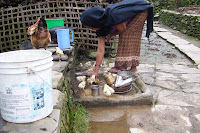
 Dadhuwa is a Gurung village comprised of 9 smaller villages. It is approximately 500 houses in total. There is no electricity, no running water, and no one owns a car though I saw 1 or 2 motorbikes. Water is collected via rain or at the river which is about a 1-hour walk one-way. However, modernity is not missing from this place altogether. Some families have solar powered lights (generally hand-held), radios, and even televisions. In the area that we stayed, cell phone reception was only available at the highest point of the hill. It was a little amusing to see people gathered in one spot to use their phones! There is a small medical clinic that is currently unmanned by a government appointed doctor. Instead, there is a gentleman with medical knowledge who is standing in for a doctor. Their supplies of medicine are limited as you can imagine.
Dadhuwa is a Gurung village comprised of 9 smaller villages. It is approximately 500 houses in total. There is no electricity, no running water, and no one owns a car though I saw 1 or 2 motorbikes. Water is collected via rain or at the river which is about a 1-hour walk one-way. However, modernity is not missing from this place altogether. Some families have solar powered lights (generally hand-held), radios, and even televisions. In the area that we stayed, cell phone reception was only available at the highest point of the hill. It was a little amusing to see people gathered in one spot to use their phones! There is a small medical clinic that is currently unmanned by a government appointed doctor. Instead, there is a gentleman with medical knowledge who is standing in for a doctor. Their supplies of medicine are limited as you can imagine. There are a few shops that carry basic supplies like coke (my only caffeine source), biscuits, toothbrushes, pens, paper, alcohol, etc. Due to the many landslides along the way, supplies were scarce while we there and there were no vegetables available. We ate dal and bhat twice a day and at great expense to our hosts, consumed meat at 3-4 meals. The villagers grow their own rice, dal, tomatoes, onions, cucumbers (that was all that I saw), but vegetables are generally imported. They also keep livestock: water buffalos (I drank warm milk fresh from the water buffalo almost everyday!), goats, cows, sheep, and lots of chickens! I also saw the occasional dog.
The Gurungs have no written script! Their language is completely oral. Present day, the children learn Nepali and English pending which school they attend. Gurung is the everyday language for those that remain in the village. The caste system is still present here. I saw a glimpse of it in action. A low-caste woman came to our host family's home but she dared not set foot inside. She remained outside and spoke through the window. The constraint was not imposed by our host family but by social rules. The low-caste woman would risk death for herself if she violated these social rules despite any invitation offered. This was a new experience for me.
Gurungs practice a blend of Hinduism and Buddhism leaning predominantly toward Mahayana Buddhism. However, the Hindu influences are undeniable. Interestingly, while visiting 5-6 of these villages, I saw very few temples and/or shrines. It was explained that most worship is practiced toward shrines/idols within the home. The Gurung people are one of the least reached for the Gospel. I didn't realize it beforehand, but God brought us to this place specifically to visit with and encourage the 1 believer in the entire community. Due to the language barrier, I never spoke directly to our host family, but I found other ways to express thanks and love. My co-worker and our Nepali friend who grew up in this village shared much encouragement with them. Further, many others in the village heard the good news for the first time! Our Nepali friend explained that many are willing to listen and even ask questions, but none are prepared to make a decision. Why? The social pressure it too great. They risk losing their rights and privileges along with access to food and water supplies. The social bonds are deep. I hope to share more about what God is doing in this village in the coming weeks!
 |
| my place of lodging |
 |
| washing dishes |
 |
| sifting chaff |

WOW! From Mom
ReplyDeletewoow !!! Rae
ReplyDelete